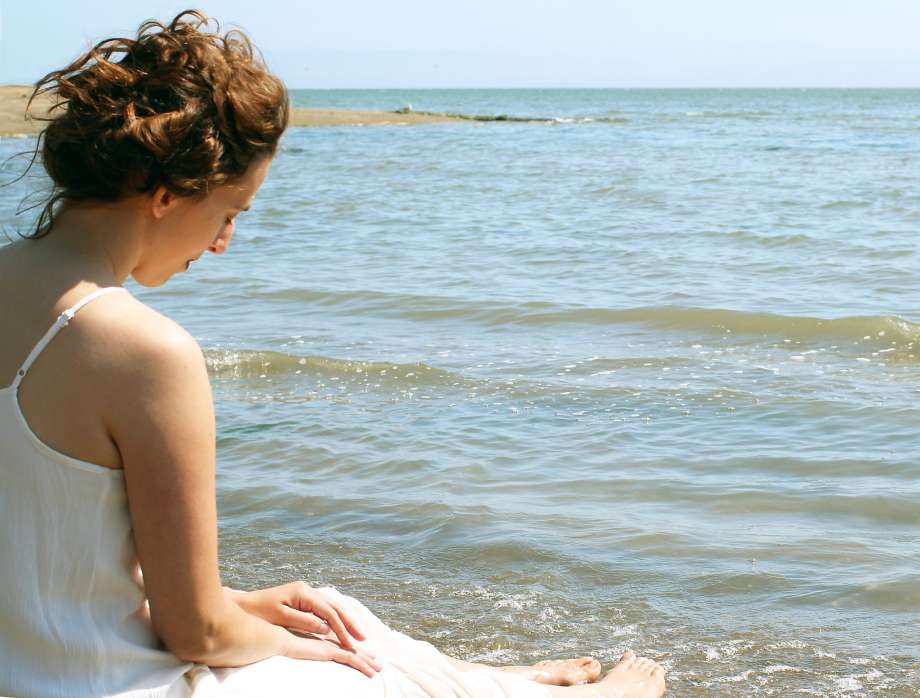By the Editors of KateChopin.org
Scholars and critics have been writing about Kate Chopin’s themes and subjects for over fifty years, and they take varied approaches to her work.
Photo by Ben Calabrese. Edna Pontellier (Maria Marquis) in The San Francisco Breadbox Theatre’s production of The Awakening.
• Many focus on themes related to women’s search for selfhood, for self-discovery or identity.
• Many also focus on women’s revolt against conformity, often against gender conformity or against social norms that limit women’s possibilities in life.
• Others write about women’s understanding of feminine sexuality or women’s experience of motherhood, pregnancy, or childbirth.
• Some look at Chopin’s female characters–at Edna Pontellier in The Awakening or Thérèse Lafirme in At Fault; at Calixta in “The Storm,” Louise Mallard in “The Story of an Hour,” or Mrs. Sommers in “A Pair of Silk Stockings”; at Désirée in “Désirée’s Baby” or Mrs. Baroda in “A Respectable Woman” or at one of the other female characters Kate Chopin offers us in her fiction.
• Some focus on Chopin’s male characters–on Léonce Pontellier, Robert Lebrun, or Alcée Arobin in The Awakening, on David Hosmer in At Fault, or on Alcée Laballière in “The Storm” or Cazeau in “Athénaïse.”
• And some scholars find themes that involve studying minor characters in the stories or novels. In The Awakening, for example, they look at characters like Adèle Ratignolle, Mademoiselle Reisz, Doctor Mandelet, or the journalist Gouvernail, who also appears in Chopin’s short stories “A Respectable Woman” and Athénaïse.”
• Other scholars are interested in how Chopin’s works and themes are related to those in the literature of the US South–or to those in romantic or realistic or naturalistic or modern fiction, or to those in literature that has an overt political agenda.
• Some deal with themes connected with Chopin’s attitude toward race, especially in short stories like “Désirée’s Baby,” “La Belle Zoraïde,” “Tante Cat’rinette,” or Nég Créol,” but also in The Awakening or in the stories Chopin published in Youth’s Companion. You can get ideas about that subject on our Questions and Answers page.
• Some compare Chopin’s themes with those of other writers–Simone de Beauvoir, Willa Cather, Ralph Waldo Emerson, Gustave Flaubert, William Dean Howells, Henrik Ibsen, Guy de Maupassant, Algernon Charles Swinburne, Alphonse Daudet, and Émile Zola, among them.
• Some focus on lesbian elements in some of Chopin’s works–like “Fedora” or “Lilacs” or The Awakening.
New: Some study religion in the works—Roman Catholicism and Presbyterianism in The Awakening, for example, or Catholicism in Chopin’s early novel At Fault.
• Some look at themes revealed by Chopin’s literary techniques, her use of imagery or parallel sentence structures, her narrative control or narrative stance or modes of disclosure.
• Some study her use of regional dialects.
• Some write about Chopin’s use of food in her works, or her focus on walking, her interest in music and painting, or her descriptions of characters’ clothing.
• Some read Chopin through a specific critical approach–stylistic analysis, psychoanalytic criticism, feminist criticism, deconstruction, Foucauldian analysis, new historicism, or reader-response analysis.
• And some find themes related to economics–to women as commodity, for example, or to Edna Poltellier’s expenditures, or to the extreme poverty in Chopin’s two books of short stories, Bayou Folk and A Night in Acadie.
You can locate what scholars and critics say about these and other themes by searching our lists of books, articles, and PhD dissertations:
Books and books of essays about Kate Chopin and her work
Articles about Kate Chopin published since 2000
Articles about Kate Chopin published from 1985 through 1999
Articles about Kate Chopin published before 1985
Kate Chopin translations and scholarship into German
Kate Chopin translations and scholarship into Portuguese
Kate Chopin translations and scholarship in Spain
PhD dissertations about Kate Chopin
